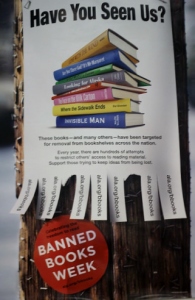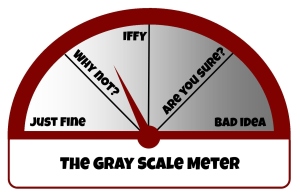Some people claim there are no moral absolutes.
I am not one of them. I believe there are some behaviors and attitudes that are unacceptable—child abuse for instance, and others that are worthy of pursuit—like self-sacrifice, honesty or faithfulness.
However, in between the black and white is an awful lot of gray. And, unfortunately, it’s not always easy to determine what is light gray (acceptable) and what is dark gray (not acceptable).
Some gray area decisions aren’t too difficult, such as the wisdom of eating three donuts for breakfast. It’s not illegal or anything, but is it a good idea? Probably not. But other gray decisions are a little trickier. What about parents who take their family to serve in an African country while the Ebola outbreak is still going on? Is this an act of noble service or child abuse? Or what about the father who declines a high-paying job offer and instead decides to make a go of it as a writer, with no guarantee of steady income at all? Is this irresponsible, or courageous? (Read Shawn Smucker’s book Building a Life out of Words to see why declining that job was the right decision for him.)
Finding our place on the Gray Scale
One problem with these shades of gray is that no two of us agree on where to draw the line. On the one hand, we don’t want to reap the consequences of straying too far into the dark end of the scale, but on the other, we shouldn’t live in fear of being defiled by any hint of darkness.
Jesus berated the Pharisees for that very attitude. In direct contrast, he fraternized with shady characters like tax collectors, had private conversations with fallen women, and touched lepers. He spent a lot of time in the gospels choosing to become ritually unclean in order to touch those who were hurting. He met them where they were, dirt, germs, shame and all.
That doesn’t mean we should seek out those same exact situations. It does mean we should understand that allowing ourselves to come in contact with questionable places and characters does not necessarily mean we have crossed the line from okay to not okay. Books like Same Kind of Different As Me show what can happen when good people decide to risk a little dirt and danger. Sure, they saw and heard some things they would rather have avoided. But they made a difference in many hurting lives. I don’t think it’s possible, in today’s world, to cling to a G-rated life and do much lasting good.
My gray should be your gray

One example of what happens when people try to foist their definition of what is OK on others. Photo Credit: ActuaLitté via Compfight cc
Another problem with all those shades of gray is that we judge each other for drawing lines in different places. What makes us think our definition of acceptably gray is correct for someone else?
For example, Focus on the Family is getting flak from other ministries for choosing to review Fifty Shades of Gray in their Plugged In magazine. I imagine those who are shocked by this never had any intention of going to see the movie. But what about all those who weren’t so convicted? If no one offered a knowledgeable Christian review, who would help them make an informed decision?
Granted, many of us draw the line well short of viewing such a movie, but that does not give us the right to condemn those who don’t. Instead of pointing fingers, shouldn’t we be grateful that Plugged In was willing to review the movie through the lens of God’s truth, so that those who were on the fence could make an informed decision?
I am not saying that we ought to push our acceptable gray limit further and further toward the dark side. I am saying that it is not our business to be the judge of other people’s standards. If we spent our energy honestly evaluating our own standards instead of complaining about someone else’s, we would make more headway in our own Christian walk, and find more unity in our churches. Isn’t that what we should be striving for?
Where do we draw the line between being in the world and not being defiled by it?
Which is worse, occasionally erring on the side or too gray, or never going anywhere near it?
Related Posts:
Fighting the Safety First Mentality

